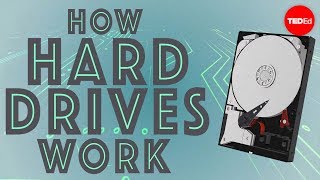Imagine an airplane flying one millimeter above the ground
想象一架飞机以离地面1毫米的高度飞行,
and circling the Earth once every 25 seconds while counting every blade of grass.
每25秒绕地球一圈,还能覆盖每一寸表面。
Shrink all that down so that it fits in the palm of your hand,
再将其缩小成手掌大小,
and you'd have something equivalent to a modern hard drive,
你就会得到和现代硬盘差不多的东西,
an object that can likely hold more information than your local library.
它所包含的信息比你们当地图书馆还要多。
So how does it store so much information in such a small space?
那么它是如何在这么小的空间储存这么多的信息呢?
At the heart of every hard drive is a stack of high-speed spinning discs with a recording head flying over each surface.
在每个硬盘的中心都有大量高速旋转的磁盘,每个磁盘的表面都有高速扫过的记录磁头。
Each disc is coated with a film of microscopic magnetised metal grains,
每个磁盘上都覆盖着一层薄薄的微小的磁化金属粒,
and your data doesn't live there in a form you can recognize.
数据以一种肉眼无法分辨的形式存在。
Instead, it is recorded as a magnetic pattern formed by groups of those tiny grains.
很多组微小颗粒形成的磁化图案记录形成了数据。
In each group, also known as a bit,
每一组,又称之为比特,
all of the grains have their magnetization's aligned in one of two possible states, which correspond to zeroes and ones.
所有微粒都按照自身的磁性排列形成两种状态之一,对应0或者1。
Data is written onto the disc by converting strings of bits into electrical current fed through an electromagnet.
将比特信息通过电磁铁转换成电流,数据就能被读写在硬盘上。
This magnet generates a field strong enough to change the direction of the metal grain's magnetization.
这块磁铁会产生一个强大磁场,足以改变金属微粒的磁性。
Once this information is written onto the disc,
当信息写入磁盘,
the drive uses a magnetic reader to turn it back into a useful form,
驱动使用磁读取器将其还原成有意义的形式,
much like a phonograph needle translates a record's grooves into music.
类似于留声机针将唱片纹路转化成音乐。
But how can you get so much information out of just zeroes and ones?
但是你是怎么从0和1中得到这么多信息的呢?
Well, by putting lots of them together.
其实是将很多很多个0和1组合在一起。
For example, a letter is represented in one byte, or eight bits,
例如,一个字节,即8比特可以代表一个字母,
and your average photo takes up several megabytes, each of which is 8 million bits.
你平均每张相片有好几兆字节,每一兆字节相当于800万比特。
Because each bit must be written onto a physical area of the disc,
由于每一比特必须写在磁盘的实体表面上,
we're always seeking to increase the disc's areal density, or how many bits can be squeezed into one square inch.
所以我们总在寻求方法增加磁盘磁录密度,或者说是增加每平方厘米能塞下的比特数。
The areal density of a modern hard drive is about 600 gigabits per square inch,
现代硬盘的磁录密度大约是每平方厘米93千兆比特,
300 million times greater than that of IBM's first hard drive from 1957.
是1957年IBM第一款硬盘的3亿倍。

This amazing advance in storage capacity wasn't just a matter of making everything smaller, but involved multiple innovations.
储存容量的巨大提升不仅仅是归因于将所有东西缩小,而是包含了许多项创新技术。
A technique called the thin film lithography process allowed engineers to shrink the reader and writer.
一种称之为薄膜光刻的技术使得工程师们可以缩小读写器。
And despite its size, the reader became more sensitive by taking advantage of new discoveries in magnetic and quantum properties of matter.
除了尺寸,利用物质磁性和量子特性上的新发现可以让读取器变得更加敏感。
Bits could also be packed closer together thanks to mathematical algorithms
数学算法的出现可以让比特被更紧凑地排列在一起,
that filter out noise from magnetic interference, and find the most likely bit sequences from each chunk of read-back signal.
能过滤电磁干扰产生的噪音,并且能从大量回读信息中找到最有可能的比特顺序。
And thermal expansion control of the head, enabled by placing a heater under the magnetic writer,
磁头热膨胀的控制是通过在磁性记录器下面放上一个加热器,
allowed it to fly less than five nanometers above the disc's surface, about the width of two strands of DNA.
使其能悬于磁盘表面5纳米以内,大约是两条DNA链的宽度。
For the past several decades,
在过去的数十年,
the exponential growth in computer storage capacity and processing power has followed a pattern known as Moore's Law,
电脑储存容量及性能的大幅度增长遵循着一种模式,称为“摩尔定律”,
which, in 1975, predicted that information density would double every two years.
这一定律于1975年预测信息密度每两年会增长一倍。
But at around 100 gigabits per square inch,
但是若每平方厘米超过15.5千兆,
shrinking the magnetic grains further or cramming them closer together posed a new risk called the superparamagnetic effect.
继续缩小磁性颗粒,或者将它们塞得更紧,则会导致“超顺磁效应”。
When a magnetic grain volume is too small,
即当磁粒体积过小,
its magnetization is easily disturbed by heat energy and can cause bits to switch unintentionally, leading to data loss.
它的磁性很容易受到热能干扰,导致比特的朝向发生混乱,从而引起数据丢失。
Scientists resolved this limitation in a remarkably simple way:
科学家们采用了一种非常简单的方法解决了这个问题:
by changing the direction of recording from longitudinal to perpendicular,
将磁记录方向由水平改为垂直,
allowing areal density to approach one terabit per square inch.
这使得磁录密度增加到接近每平方厘米0.155太(1000千兆)字节。
Recently, the potential limit has been increased yet again through heat assisted magnetic recording.
最近,通过热辅助磁记录技术,磁录密度又提升了。
This uses an even more thermally stable recording medium,
这种技术采用了一种热稳定记录介质,
whose magnetic resistance is momentarily reduced by heating up a particular spot with a laser and allowing data to be written.
通过在局部进行激光加热来短暂减小磁阻力,从而实现写入数据。
And while those drives are currently in the prototype stage,
尽管这些驱动磁盘还处于原型阶段,
scientists already have the next potential trick up their sleeves:
科学家们已经又玩出了新花样:
bit-patterned media, where bit locations are arranged in separate, nano-sized structures,
位元规则媒介,比特对应的位置被安置于独立的纳米大小的结构,
potentially allowing for areal densities of twenty terabits per square inch or more.
潜在地实现了磁录密度至每平方厘米3.1太字节,甚至更多。
So it's thanks to the combined efforts of generations of engineers, material scientists, and quantum physicists
多亏了一代又一代工程师,材料科学家,还有量子物理学家们的共同努力,
that this tool of incredible power and precision can spin in the palm of your hand.
这个拥有不可思议的能量,无比精确的小工具才能在你手掌中旋转。











